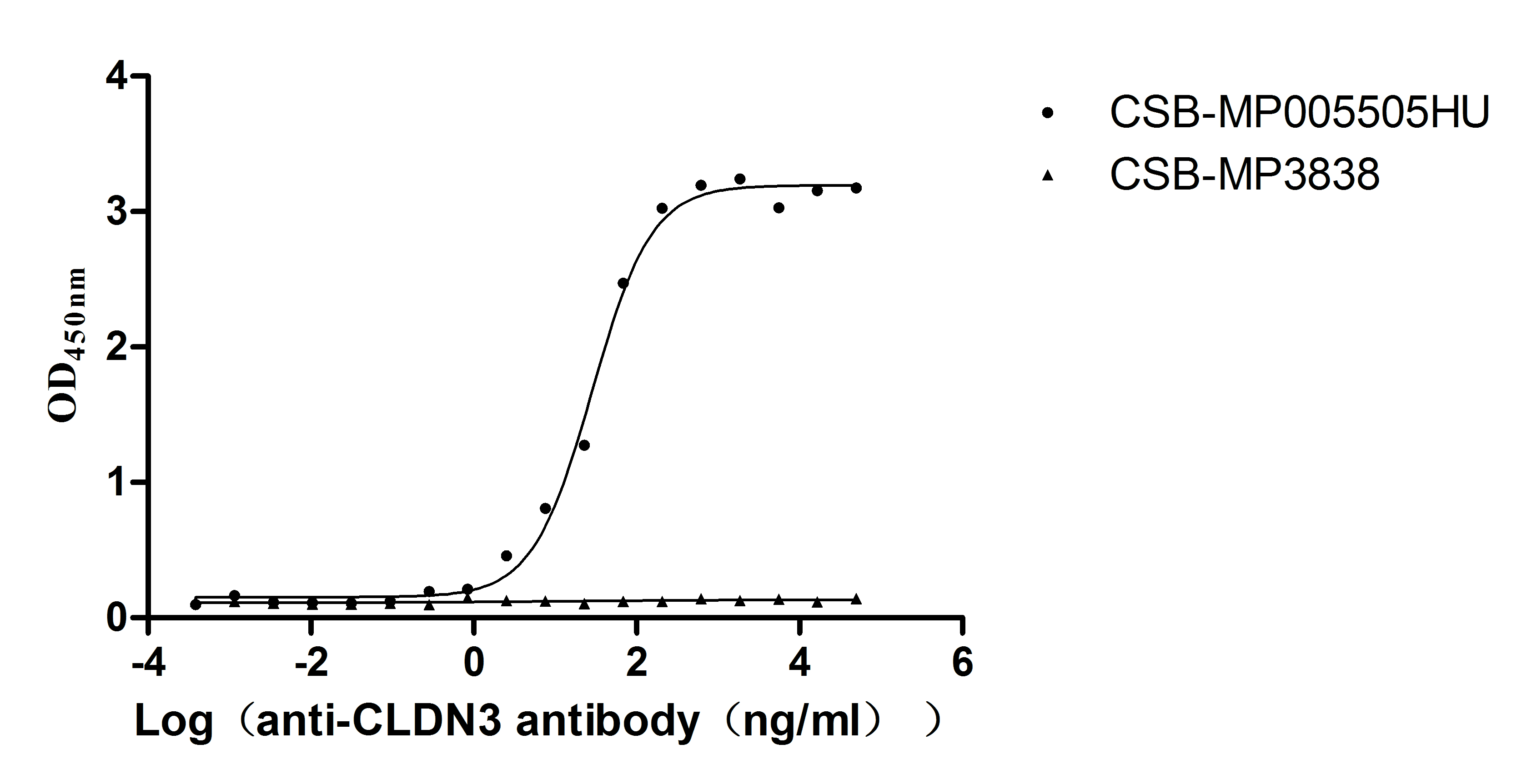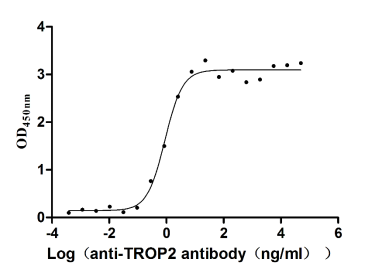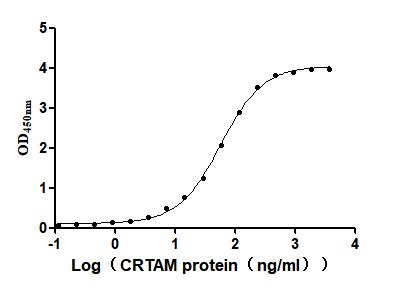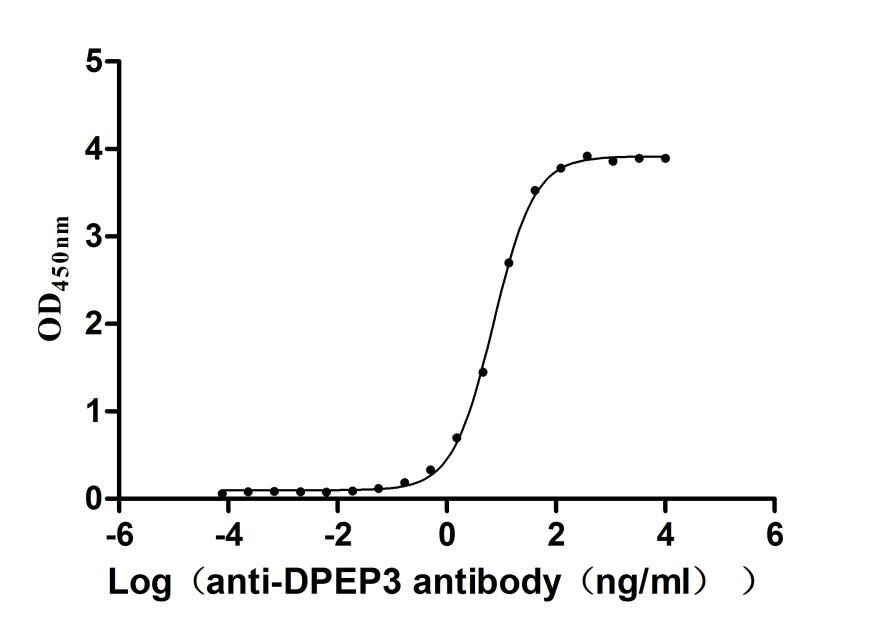Recombinant Human Receptor-type tyrosine-protein phosphatase delta (PTPRD), partial (Active)
In Stock-
貨號(hào):CSB-MP019051HU(A4)
-
規(guī)格:¥1140
-
圖片:
-
(Tris-Glycine gel) Discontinuous SDS-PAGE (reduced) with 5% enrichment gel and 15% separation gel.
-
Activity
Measured by its binding ability in a functional ELISA. Immobilized Human PTPRD protein at 2 μg/ml can bind Human IL1RAPL1 protein (CSB-MP011624HU1). The EC50 is 3.361-4.394 ng/mL. Biological Activity Assay -
The purity of PTPRD was greater than 95% as determined by SEC-HPLC
-
-
其他:
產(chǎn)品詳情
-
純度:Greater than 95% as determined by SDS-PAGE.
Greater than 95% as determined by SEC-HPLC. -
內(nèi)毒素:Less than 1.0 EU/ug as determined by LAL method.
-
生物活性:Measured by its binding ability in a functional ELISA. Immobilized Human PTPRD protein at 2 μg/mL can bind Human IL1RAPL1 protein (CSB-MP011624HU1). The EC50 is 3.361-4.394 ng/mL.
-
基因名:
-
Uniprot No.:
-
別名:Receptor-type tyrosine-protein phosphatase delta; EC:3.1.3.48; Protein-tyrosine phosphatase delta;?R-PTP-delta; PTPRD
-
種屬:Homo sapiens (Human)
-
蛋白長(zhǎng)度:Partial
-
來(lái)源:Mammalian cell
-
分子量:139.6 kDa
-
表達(dá)區(qū)域:21-1265aa
-
氨基酸序列ETPPRFTRTPVDQTGVSGGVASFICQATGDPRPKIVWNKKGKKVSNQRFEVIEFDDGSGSVLRIQPLRTPRDEAIYECVASNNVGEISVSTRLTVLREDQIPRGFPTIDMGPQLKVVERTRTATMLCAASGNPDPEITWFKDFLPVDTSNNNGRIKQLRSESIGGTPIRGALQIEQSEESDQGKYECVATNSAGTRYSAPANLYVRELREVRRVPPRFSIPPTNHEIMPGGSVNITCVAVGSPMPYVKWMLGAEDLTPEDDMPIGRNVLELNDVRQSANYTCVAMSTLGVIEAIAQITVKALPKPPGTPVVTESTATSITLTWDSGNPEPVSYYIIQHKPKNSEELYKEIDGVATTRYSVAGLSPYSDYEFRVVAVNNIGRGPPSEPVLTQTSEQAPSSAPRDVQARMLSSTTILVQWKEPEEPNGQIQGYRVYYTMDPTQHVNNWMKHNVADSQITTIGNLVPQKTYSVKVLAFTSIGDGPLSSDIQVITQTGVPGQPLNFKAEPESETSILLSWTPPRSDTIANYELVYKDGEHGEEQRITIEPGTSYRLQGLKPNSLYYFRLAARSPQGLGASTAEISARTMQSKPSAPPQDISCTSPSSTSILVSWQPPPVEKQNGIITEYSIKYTAVDGEDDKPHEILGIPSDTTKYLLEQLEKWTEYRITVTAHTDVGPGPESLSVLIRTNEDVPSGPPRKVEVEAVNSTSVKVSWRSPVPNKQHGQIRGYQVHYVRMENGEPKGQPMLKDVMLADAQWEFDDTTEHDMIISGLQPETSYSLTVTAYTTKGDGARSKPKLVSTTGAVPGKPRLVINHTQMNTALIQWHPPVDTFGPLQGYRLKFGRKDMEPLTTLEFSEKEDHFTATDIHKGASYVFRLSARNKVGFGEEMVKEISIPEEVPTGFPQNLHSEGTTSTSVQLSWQPPVLAERNGIITKYTLLYRDINIPLLPMEQLIVPADTTMTLTGLKPDTTYDVKVRAHTSKGPGPYSPSVQFRTLPVDQVFAKNFHVKAVMKTSVLLSWEIPENYNSAMPFKILYDDGKMVEEVDGRATQKLIVNLKPEKSYSFVLTNRGNSAGGLQHRVTAKTAPDVLRTKPAFIGKTNLDGMITVQLPEVPANENIKGYYIIIVPLKKSRGKFIKPWESPDEMELDELLKEISRKRRSIRYGREVELKPYIAAHFDVLPTEFTLGDDKHYGGFTNKQLQSGQEYVFFVLAVMEHAESKMYATSPYSDPVVSMDLDPQPITDEEE
-
蛋白標(biāo)簽:C-terminal 10xHis-tagged
-
產(chǎn)品提供形式:Lyophilized powder
Note: We will preferentially ship the format that we have in stock, however, if you have any special requirement for the format, please remark your requirement when placing the order, we will prepare according to your demand. -
緩沖液:Lyophilized from a 0.2 μm filtered PBS, 6% Trehalose, pH 7.4
-
復(fù)溶:We recommend that this vial be briefly centrifuged prior to opening to bring the contents to the bottom. Please reconstitute protein in deionized sterile water to a concentration of 0.1-1.0 mg/mL.We recommend to add 5-50% of glycerol (final concentration) and aliquot for long-term storage at -20°C/-80°C. Our default final concentration of glycerol is 50%. Customers could use it as reference.
-
儲(chǔ)存條件:Store at -20°C/-80°C upon receipt, aliquoting is necessary for mutiple use. Avoid repeated freeze-thaw cycles.
-
保質(zhì)期:The shelf life is related to many factors, storage state, buffer ingredients, storage temperature and the stability of the protein itself.
Generally, the shelf life of liquid form is 6 months at -20°C/-80°C. The shelf life of lyophilized form is 12 months at -20°C/-80°C. -
貨期:3-7 business days
-
注意事項(xiàng):Repeated freezing and thawing is not recommended. Store working aliquots at 4°C for up to one week.
-
Datasheet & COA:Please contact us to get it.
相關(guān)產(chǎn)品
靶點(diǎn)詳情
-
功能:Can bidirectionally induce pre- and post-synaptic differentiation of neurons by mediating interaction with IL1RAP and IL1RAPL1 trans-synaptically. Involved in pre-synaptic differentiation through interaction with SLITRK2.
-
基因功能參考文獻(xiàn):
- PTPRD rs35929428 might play a role in hepatic lipid accumulation and fibrosis, followed by the development of NAFLD. PMID: 28497593
- Results show the existence of a perturbed PTPRD-STAT3 axis potentially driving malignant progression of Hepatitis C virus-associated liver disease. PMID: 28159835
- Presynaptic differentiation induced by protein tyrosine phosphatase receptor type D (PTPdelta)-leucine rich repeat and fibronectin type III domain containing 5 (SALM5) requires the dimeric property of SALM5. PMID: 29348429
- In the 2:2 heterotetrameric SALM5/PTPdelta complex, a SALM5 dimer bridges two separate PTPdelta molecules. PMID: 29348579
- our study suggested that PTPRD loci are candidate susceptibility regions that have some marker SNPs for GDM in Han Chinese PMID: 27738328
- We investigated the modification of air pollution and diabetes association by a genetic risk score covering 63 T2D genes. Five single variants near GRB14, UBE2E2, PTPRD, VPS26A and KCNQ1 showed nominally significant interactions with PM10 (P<0.05). Our results suggest that genetic risk for T2D may modify susceptibility to air pollution through alterations in insulin sensitivity PMID: 27281273
- Mutation in PTPRD gene is associated with nodal marginal zone lymphoma. PMID: 27335277
- Low PTPRD expression is associated with Head and Neck Squamous Cell Carcinoma. PMID: 27501229
- The data provide evidence of the high incidence of PTPRD inactivation in laryngeal squamous cell carcinoma, suggesting that deletions and loss-of-function mutations are responsible for PTPRD loss only in a fraction of cases, whereas DNA methylation is the dominating mechanism of PTPRD inactivation. PMID: 28345455
- PTPRD polymorphisms might modulate antipsychotic-induced weight gain. PMID: 26656879
- overexpression in acute myeloid leukaemia cells inhibited cell proliferation and clonogenicity as well as inducing apoptosis PMID: 26607758
- PTPRD was identified as a novel locus potentially associated with blood pressure response to atenolol and resistant hypertension in multiple ethnic groups. PMID: 26425837
- PTPRD mutation, but not methylation or copy number loss, may serve as a predictive biomarker of sensitivity to STAT3 inhibitors in HNSCC. PMID: 26267899
- Study shows for the first time that DNMT1 caused PTPRD DNA hypermethylation and induced insulin signaling silencing in T2D patients. PMID: 26079428
- PTPRD is homozygously deleted and epigenetically downregulated in hepatocellular carcinomas (HCCs). PMID: 25831062
- This study demonstrated that the copy number variations of PTPRD relate to opioid dependence. PMID: 25345593
- Silencing PTPRD expression by siRNA treatment significantly enhanced cell proliferation compared with mock siRNA treatment. PMID: 25412184
- we report desmoplakin, a desmosomal protein that is implicated in cell-cell adhesion, as a novel PTPRD substrate. PMID: 25113440
- Ptprd is a tumor suppressor that can promote tumorigenesis in concert with Cdkn2a loss. PMID: 25138050
- The absence of MIM led to PTPdelta-mediated activation of SRC. PMID: 25287652
- We reveal that PTPRD is a bona fide tumor suppressor, pinpoint PTPRD loss as a cause of aberrant STAT3 activation in gliomas, and establish PTPRD loss, in the setting of CDKN2A/p16(INK4A) deletion, as a driver of glioma progression. PMID: 24843164
- Data suggest that PTPRD germline mutations may play a role in the development of Ewing sarcoma. PMID: 23800680
- Data indicate that expression of several predicted chimeric genes and genes with disrupted exon structure including ALK, NBAS, FHIT, PTPRD and ODZ4 in neuroblastoma. PMID: 23991058
- Loss of PTPRD gene is associated with squamous cell carcinomas of the vulva. PMID: 23404381
- Polymorphism in protein tyrosine phosphatase receptor delta is associated with the risk of clear cell renal cell carcinoma. PMID: 23069849
- This is the first report to observe an association between deletion within PTPRD and metastatic cutaneous squamous cell carcinoma. PMID: 22052591
- Although endogenous PTPdelta expression was very low in neuroblastoma cells, it was also low in mouse embryo adrenal glands, suggesting that PTPdelta may have little developmental function in early adrenal neuroblasts. PMID: 22571343
- Data indicate that genetic variants near the KCNQ1 and MAF/WWOX genes are associated with reduced insulin secretion, and the PTPRD genetic variant appears to be associated with progression to diabetes in Han Chinese. PMID: 21767287
- PTPRD has a tumor suppressor function in neuroblastoma through AURKA dephosphorylation and destabilization and a downstream destabilization of MYCN protein, representing a novel mechanism for the function of PTPRD in neuroblastoma. PMID: 22305495
- The interaction of the IL1RAPL1 family of proteins with PTPdelta and RhoGAP2 reveals a pathophysiological mechanism of cognitive impairment associated with a novel type of trans-synaptic signaling. PMID: 21926414
- Eight suggestive significant loci were detected with a series of genes expressed within the inner ear that underlie the auditory function, such as: DCLK1, PTPRD, GRM8, CMIP. PMID: 21493956
- Both family-based and population-based association studies suggest that PTPRD variant rs1975197 confers risk of RLS. PMID: 21264940
- statistical significant downregulation of PCDH17/PCH68 and PTPRD was observed PMID: 21213369
- Results found the PTPRD gene was most frequently homozygously deleted gene in human lung cancer among genes mapping to regions other than 9p21. PMID: 20073072
- Trans-synaptic adhesions between netrin-G ligand-3 (NGL-3) and receptor tyrosine phosphatases LAR, protein-tyrosine phosphatase delta (PTPdelta), and PTPsigma via specific domains regulate excitatory synapse formation. PMID: 20139422
- A novel isoform of PTPRD was cloned and its expression analyzed. PMID: 16114034
- data identify PTPRD as a candidate tumor suppressor gene in cutaneous squamous cell carcinoma with a possible association with metastasis PMID: 17420988
- The aberrant splicing or microdeletion of 5' UTR exons in such a high proportion of tumors indicates that loss of these exons dys-regulates the mRNA sequence PMID: 18050303
- The results indicate that polymorphisms of PTPRD are strongly associated with pediatric bronchial asthma in the Taiwanese population. PMID: 18414509
- Two independent SNPs in the 5' UTR of splice variants expressed predominantly in the central nervous system showed highly significant P values, identifying PTPRD as the fourth genome-wide significant locus for restless legs syndrome. PMID: 18660810
- These results implicate PTPRD as a tumor suppressor on chromosome 9p that is involved in the development of glioblastoma multiforme and multiple human cancers. PMID: 19478061
- No mutations of PTPRD were associated with familiar melanoma PMID: 19500277
- Identification of ZNF366 and PTPRD as novel determinants of plasma homocysteine in a family-based genome-wide association study PMID: 19525478
顯示更多
收起更多
-
亞細(xì)胞定位:Membrane; Single-pass type I membrane protein.
-
蛋白家族:Protein-tyrosine phosphatase family, Receptor class 2A subfamily
-
數(shù)據(jù)庫(kù)鏈接:
Most popular with customers
-
Recombinant Human Claudin-3 (CLDN3)-VLPs (Active)
Express system: Mammalian cell
Species: Homo sapiens (Human)
-
Recombinant Human Tumor-associated calcium signal transducer 2 (TACSTD2), partial (Active)
Express system: Mammalian cell
Species: Homo sapiens (Human)
-
Recombinant Mouse Cytotoxic and regulatory T-cell molecule (Crtam), partial (Active)
Express system: Mammalian cell
Species: Mus musculus (Mouse)
-
Recombinant Human Dipeptidase 3(DPEP3), partial (Active)
Express system: Mammalian cell
Species: Homo sapiens (Human)
-
Recombinant Human Cadherin-1(CDH1),partial (Active)
Express system: Mammalian cell
Species: Homo sapiens (Human)

-SDS.jpg)
-AC1.jpg)
-HPLC.jpg)















